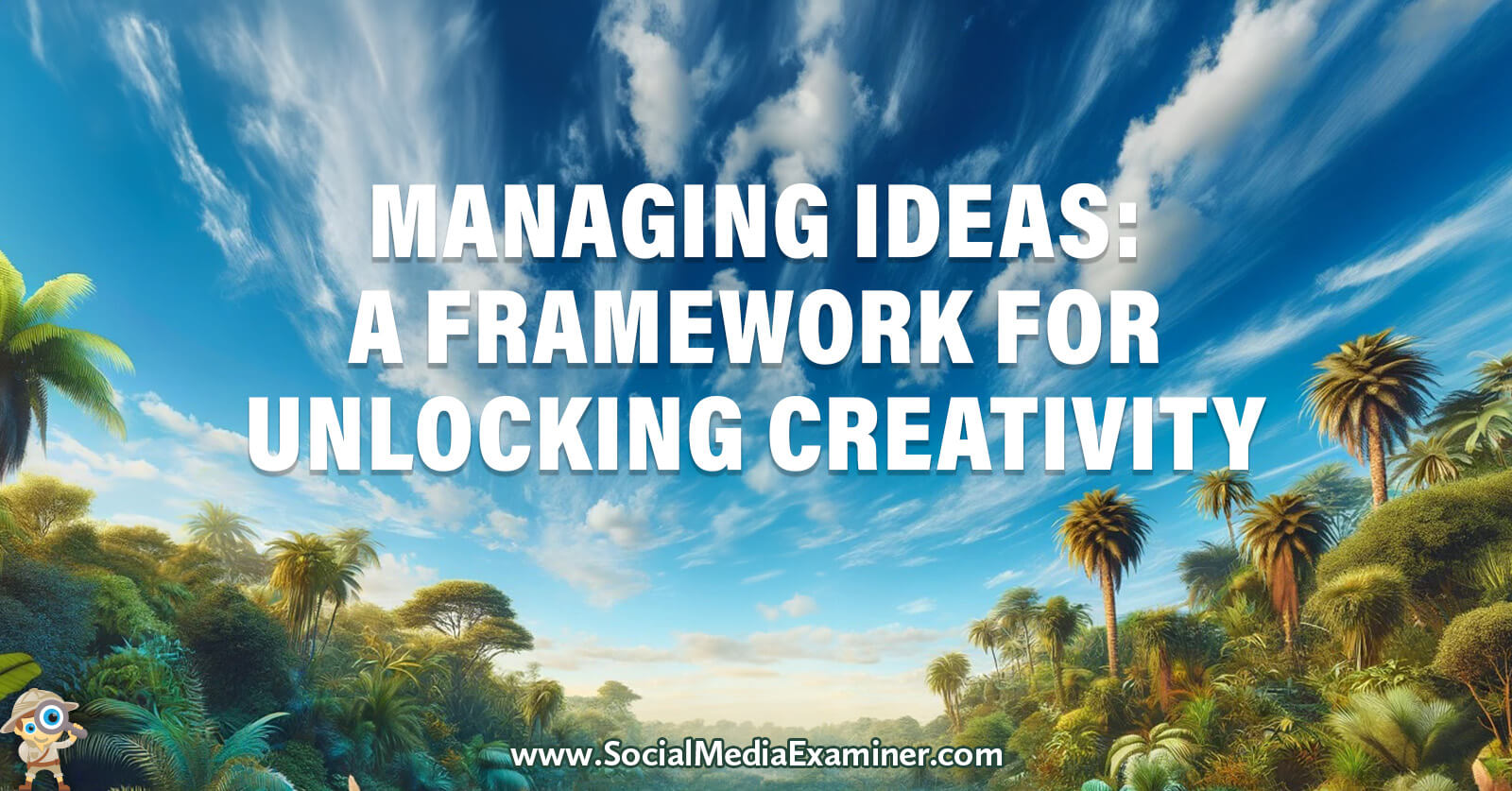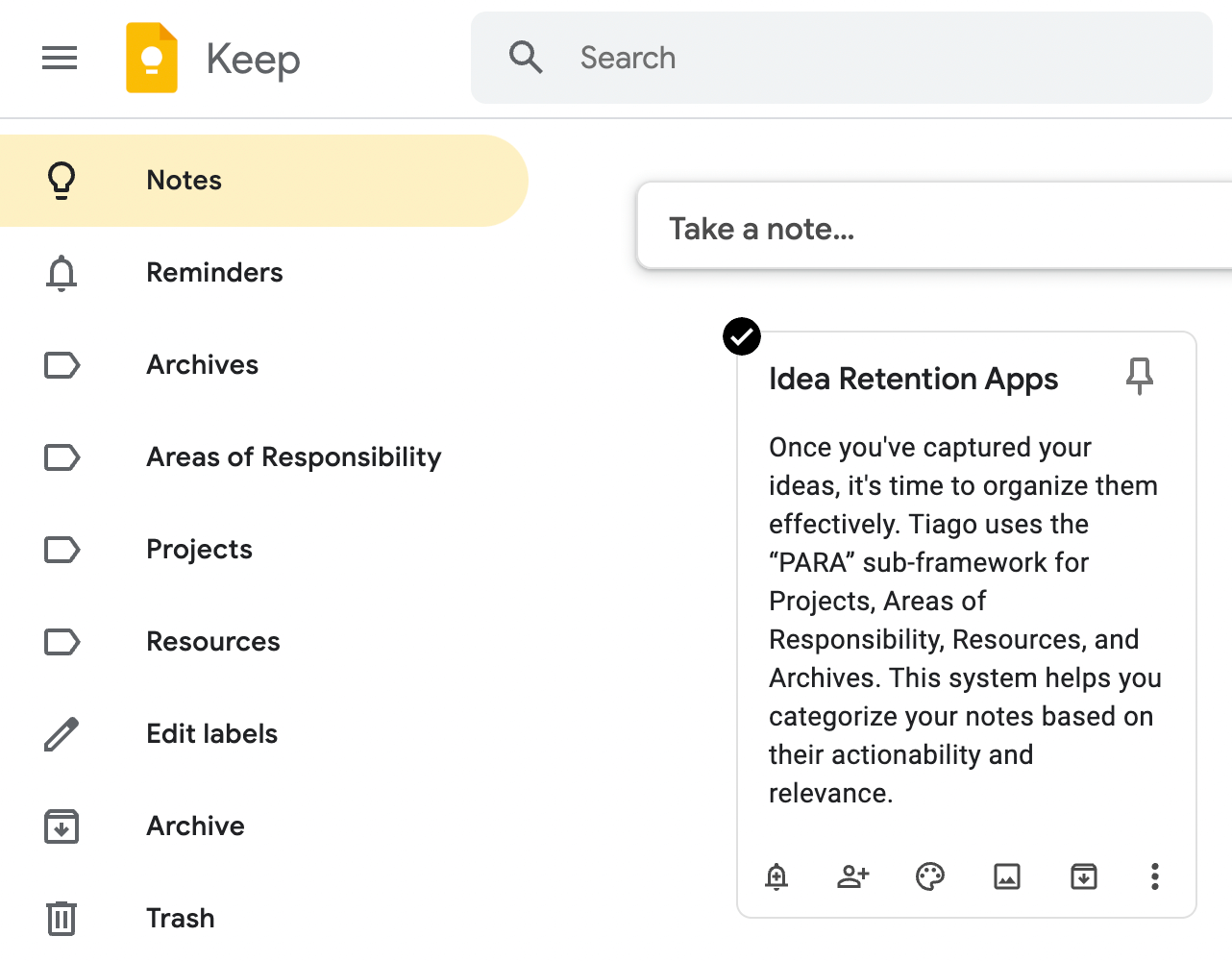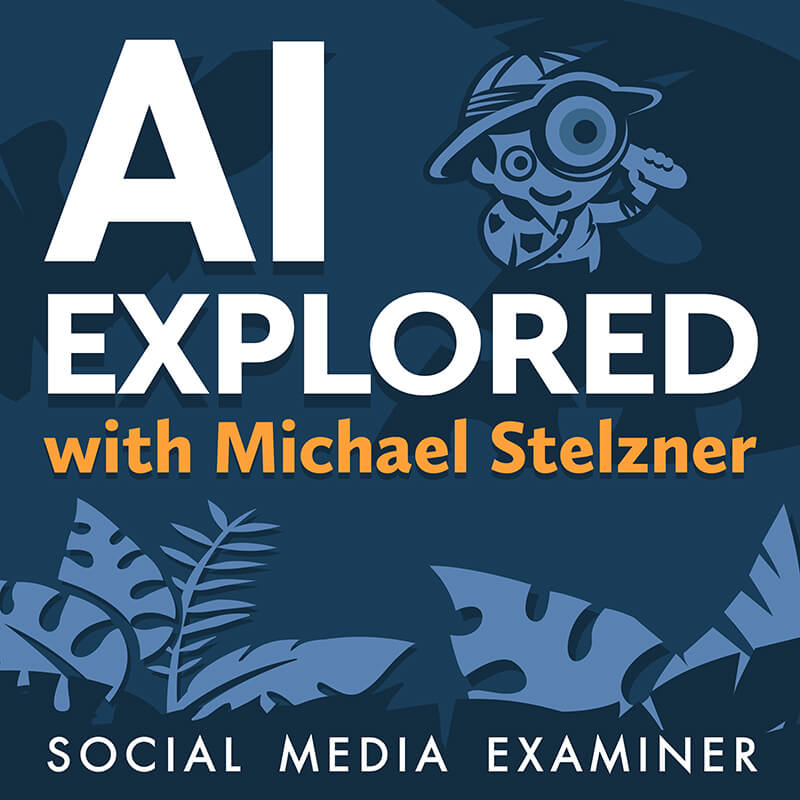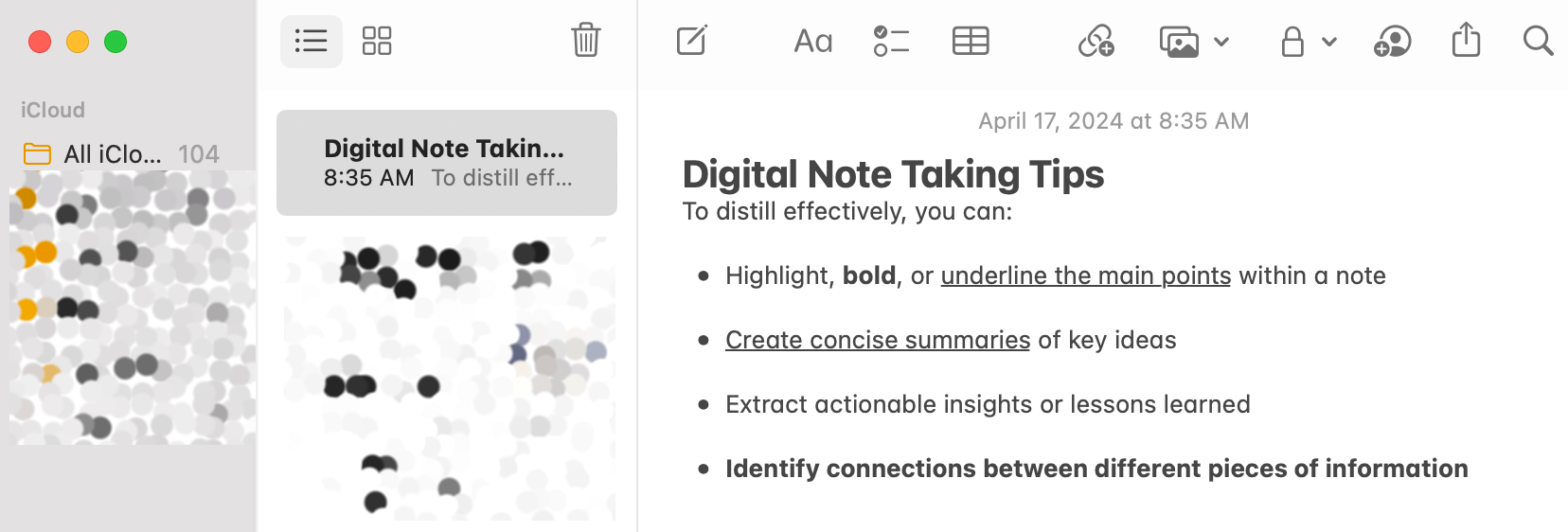Do your best ideas get lost? Are you looking for a proven process to capture and act on your ideas?
In this article, you’ll discover how to create systems to help you better manage your ideas.

Why Is Idea Management Important?
In today's fast-paced, information-driven world, it's easy to feel overwhelmed by the sheer volume of ideas, insights, and knowledge we encounter daily. As marketers and creators, we often struggle to keep up with the constant influx of information, leading to missed opportunities and untapped potential. Tiago Forte, founder of Forte Labs and author of Building a Second Brain, has developed an idea management framework to help you organize your digital lives and unlock your creative potential.
Before diving into the framework, it's crucial to understand why idea management is so essential. Tiago explains that we are all knowledge workers, regardless of our specific roles or industries. From restaurant managers to construction workers, truck drivers to marketers, we all deal with an incredible amount of information that we must not only consume but also make sense of and use effectively.
The problem arises when we rely solely on our biological brains (which Tiago calls our “first brains”) to store and manage this information. Our minds, while powerful, have limited capacity and are susceptible to forgetfulness, distractions, and stress. By creating a “second brain”—an external, trusted system for storing and organizing our ideas—we can free up mental space, be more present, enhance productivity, and tap into our creative potential.
How to Manage Your Ideas and Unlock Your Creativity: The ‘CODE’ Framework
The “CODE” framework consists of four key steps to organize and track ideas and release your creative output: Capture, Organize, Distill, and Express. Following this idea management process can create a robust and effective second brain that supports your personal and professional growth.
#1: Capture Your Ideas, Insights, and Knowledge Regularly
The first step involves getting information out of your head and into a digital note-taking system.
Here are some tips and strategies to effectively capture ideas:
- Embrace digital note-taking: Choose an app that suits your needs and preferences. Some popular options include Apple Notes, Evernote, Google Keep, Notion, Obsidian, Microsoft Onenote, Readwise, Simplenote, and Snipd. Ensure that your chosen idea management platform is accessible and easy to use across your devices.

- Be selective: Focus on capturing the most interesting, novel, and impactful 1% of the content. Trust your intuition, and capture the information that resonates with you. For example, this could be just a few lines or quotes from a podcast episode. Doing this creates a mental bookmark that prompts your brain to remember the rest of the content. If you need to revisit the original source in the future for idea generation or inspiration, you'll know it exists and can easily access it. It's also good practice to keep links to the original source in your notes to quickly find the full content when needed.
- Use multiple capture methods: Leverage various idea management tools and techniques to capture ideas, such as saving quotes from articles, snippets from podcasts, or segments from YouTube videos, creating voice memos, clipping websites, or jotting down personal observations. The more options you have for capturing, the more likely you are to document your ideas consistently.
- Make it a habit: Incorporate idea capture into your daily routine. Set aside time for reading, listening to podcasts, or engaging with content, and actively look for ideas worth saving. The more you practice capturing, the more naturally it will come to you.
#2: Organize Your Ideas Diligently
Once you've captured your ideas, it's time to organize them effectively. Tiago uses the “PARA” sub-framework for Projects, Areas of Responsibility, Resources, and Archives. This system helps you categorize your notes based on their actionability and relevance. Here’s how you can apply this sub-framework to your second brain:

- Create project-specific folders: Set up folders or tags for each of your active projects that have clear goals and outcomes, and store relevant notes, documents, and resources within these folders. Prioritize organizing your notes based on your current projects to help you quickly access the information you need.
- Establish areas of responsibility: Identify the key areas of your life and work, such as marketing, personal development, or health, and create corresponding folders. Use these folders to store notes and resources related to these broader categories.
- Curate resource collections: Create folders for topics you're interested in learning about or exploring further, like psychology or creativity. These resource collections encompass all the miscellaneous information that is not immediately actionable or doesn’t relate to a specific project or area of responsibility but is still valuable for future reference.
- Maintain an archive: Regularly review your notes and move inactive or less relevant information to an archive folder. Think of archives as a basement, storage closet, or garage where you keep old boxes of stuff you don't know what to do with. Archiving helps keep your second brain clutter-free and focused on current priorities while preserving valuable insights for future reference.
It’s important to be specific with your folder/project names. Let's say you're listening to a podcast and hear a great marketing idea about using specific types of content on LinkedIn to capture leads for your business. Instead of simply categorizing this idea under a broad “marketing” label, use a more specific label like “Diversify content to LinkedIn.”

Discover Proven Marketing Strategies and Tips
Want to go even deeper with your marketing? Check out the Social Media Marketing Podcast! Publishing weekly since 2012, the Social Media Marketing Podcast helps you navigate the constantly changing marketing jungle, with expert interviews from marketing pros.
But don’t let the name fool you. This show is about a lot more than just social media marketing. With over 600 episodes and millions of downloads each year, this show has been a trusted source for marketers for well over a decade.
In your note-taking app, you can create connections that resemble the human brain, with ideas linked across categories and projects without any silos. While an idea could relate to multiple projects or areas, it's best to take a moment and decide where it will be most useful or relevant soon. This simple decision will ensure that you place the idea in a location where it's most likely helpful when needed.
Think of the “PARA” framework as a pyramid with active projects at the top and your archives at the bottom. This visual hierarchy can help you quickly access, prioritize, and manage your notes effectively.
#3: Distill the Main Points Strategically
The third step in the “CODE” framework is to distill your captured and organized information into its most essential and actionable form. It’s often the missing piece. Distillation involves highlighting key points, summarizing main ideas, and extracting valuable insights from your notes.
Tiago stresses that this step often demands cognitive effort and requires a strategic approach. Instead of distilling all your notes simultaneously, he recommends waiting until you're actively working on a specific project or goal and then distilling the notes relevant to that project. This approach ensures that the effort you put into distillation will be immediately helpful and valuable.
Curious About How to Use AI?

We just launched a new show that help marketers, creators, and entrepreneurs understand the business applications of AI.
It's hosted by Michael Stelzner and explores this exciting new frontier in easy-to-understand terms.
Pull up your favorite podcast app and search for AI Explored. (Look for the cover art shown to the right.)
Or click the button below for more information.
To distill information effectively, you can:
- Highlight, bold, or underline the main points within a note
- Create concise summaries of key ideas
- Extract actionable insights or lessons learned
- Identify connections between different pieces of information

Distilling your notes will make it easier for your future self to grasp and apply essential information quickly to your work.
For example, when working on a technical and not inherently enjoyable project, like personalizing email marketing, you can distill your information to get back into the right mindset. Before each work session, take a moment to distill and summarize the meeting notes from the previous session. This can help you recall the necessary details and prepare you to tackle complex tasks. Reviewing the notes lets you quickly load up the essential information and context, making it the perfect way to begin working on the project again.
#4: Express Your Ideas Confidently
The final step in the “CODE” framework is to express your ideas and knowledge through your chosen medium. This is where your second brain truly shines. Instead of starting from scratch or relying on your memory, you’ll have a rich collection of pre-vetted, relevant, and valuable ideas and insights to draw from as you create content, make decisions, or communicate with others.
Turn to your notes and determine the most appropriate medium for expressing your ideas based on your role, goals, audience, and strengths. This could include:
- Writing articles, blog posts, or social media updates
- Creating videos, podcasts, or presentations
- Designing graphics or illustrations
- Composing emails or reports
- Engaging in conversations or discussions
Having a well-organized second brain to reference lets you approach the expression phase confidently and clearly. Knowing you have a dedicated idea management system will enable you to think more deeply and explore new possibilities. This makes the creative process more efficient and allows you to focus on producing higher-quality, more impactful work. You may develop more original ideas or make connections that you wouldn't have otherwise.
Tiago Forte is founder of Forte Labs, a company that helps people be more productive in the digital world. He’s the author of Building a Second Brain: A Proven Method to Organize Your Digital Life and Unlock Your Creative Potential. He’s also host of The Building a Second Brain Podcast, and his course is Building a Second Brain. You can find him on X and LinkedIn.
Other Notes From This Episode
- Connect with Michael Stelzner @Stelzner on Instagram and @Mike_Stelzner on X .
- Watch this interview and other exclusive content from Social Media Examiner on YouTube.
Listen to the Podcast Now
This article is sourced from the Social Media Marketing Podcast, a top marketing podcast. Listen or subscribe below.
Where to subscribe: Apple Podcasts | Spotify | YouTube Music | YouTube | Amazon Music | RSS
✋🏽 If you enjoyed this episode of the Social Media Marketing podcast, please head over to Apple Podcasts, leave a rating, write a review, and subscribe.
Stay Up-to-Date: Get New Marketing Articles Delivered to You!
Don't miss out on upcoming social media marketing insights and strategies! Sign up to receive notifications when we publish new articles on Social Media Examiner. Our expertly crafted content will help you stay ahead of the curve and drive results for your business. Click the link below to sign up now and receive our annual report!
Attention Agency Owners, Brand Marketers, and Consultants

Introducing the Marketing Agency Show–our newest podcast designed to explore the struggles of agency marketers.
Join show host and agency owner, Brooke Sellas, as she interviews agency marketers and digs deep into their biggest challenges. Explore topics like navigating rough economic times, leveraging AI, service diversification, client acquisition, and much more.
Just pull up your favorite podcast app, search for Marketing Agency Show and start listening. Or click the button below for more information.

